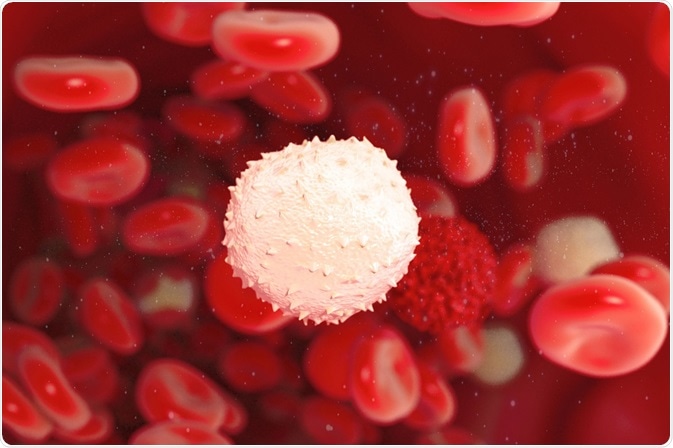T cells are a type of lymphocyte, or white blood cell, that play an important role in the adaptive immune system.

Credit: royaltystockphoto.com/Shutterstock.com
There are several types of T cells. Effector T cells include the categories of helper, killer, memory, and regulatory T cells. Helper T cells recruit other lymphocytes in an immune response. Cytotoxic, or killer, T cells destroy infected cells.
Memory T cells are long-lived and can expand quickly to large numbers of effector T cells if they are re-exposed to their cognate antigen. Regulatory T cells maintain immunological tolerance by shutting down T cell-mediated immunity when an immune response is complete and suppressing autoreactive T cells.
T cells develop from hematopoietic stem cells in the bone marrow. Progenitors of those cells migrate to the thymus, here they are known as thymocytes. Thymocytes mature in a series of steps based on the development of cell surface markers. Most cells in the thymus develop into ɑβ T cells, while about 5% become γδ T cells.
Immature T cells do not express either the CD4 or CD8 antigen. They are known as double-negative (DN) cells (CD4-CD8-). Through the process of development, they become double-positive cells (CD4+CD8+), then mature into single-positive (CD4+CD8- or CD4-CD8+) thymocytes and are released to peripheral tissues.
Most thymocytes die in the process of development. The remaining 2% become mature T cells.
Double-negative stage
The double-negative stage of T cell development is divided further into 4 stages, DN1-DN4. DN1 cells are heterogeneous and may give rise to ɑβ T cells, γδ T cells, natural killer (NK) cells, dendritic cells, macrophages, or B cells.
The DN1 stage can be broken down further into five different subsets based on the expression of CD117 and CD24. Subsets DN1a and DN1b express CD117 and most potently produce T-lineage cells.
DN2 cells migrate through the cortex of the thymus and begin the rearrangement of gene segments. They are committed to the T cell lineage after transitioning from DN2 to DN3. A further rearrangement of genes results in β-selection, which leads to the development of ɑβ T cells. In stage DN4, expression of CD4 and CD8 is upregulated to yield double-positive (DP) cells, which undergo further gene rearrangements.
Double-positive stage
DP cells that have undergone successful gene rearrangements are subjected to positive and negative selection in the cortex, and negative selection in the medulla. Positive selection results in the development of CD4+ helper or CD8+ cytotoxic lineages.
Mature CD4+ and CD8+ single-positive cells leave the thymus and circulate in the bloodstream. γδ T cells do not undergo a positive selection process the same way that ɑβ T cells do.
The thymic microenvironment
Thymic epithelial cells interact with thymocytes to aid the development of T cells. The thymic epithelium produces chemokines, cytokines, and ligands which promote development of progenitor cells.
Activation of T cells
T cells are activated when the T cell receptor is engaged combined with a costimulatory molecule such as CD28 by the major histocompatibility complex (MHCII) peptide and costimulatory molecules of the antigen-presenting cells. Costimulation is necessary for T cell activation. Once activated, the cell alters expression of its surface proteins and its glycosylation profile.
Further Reading